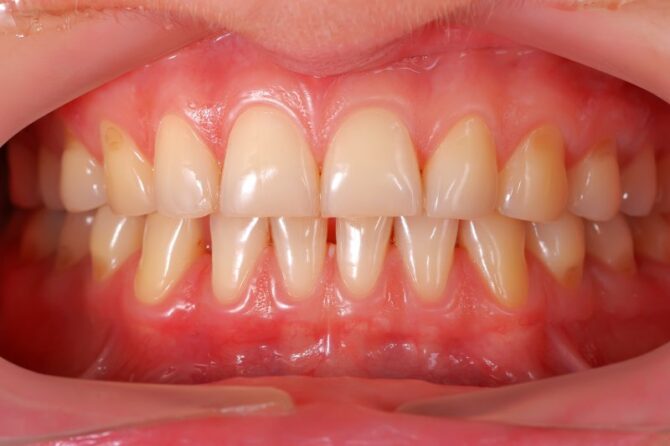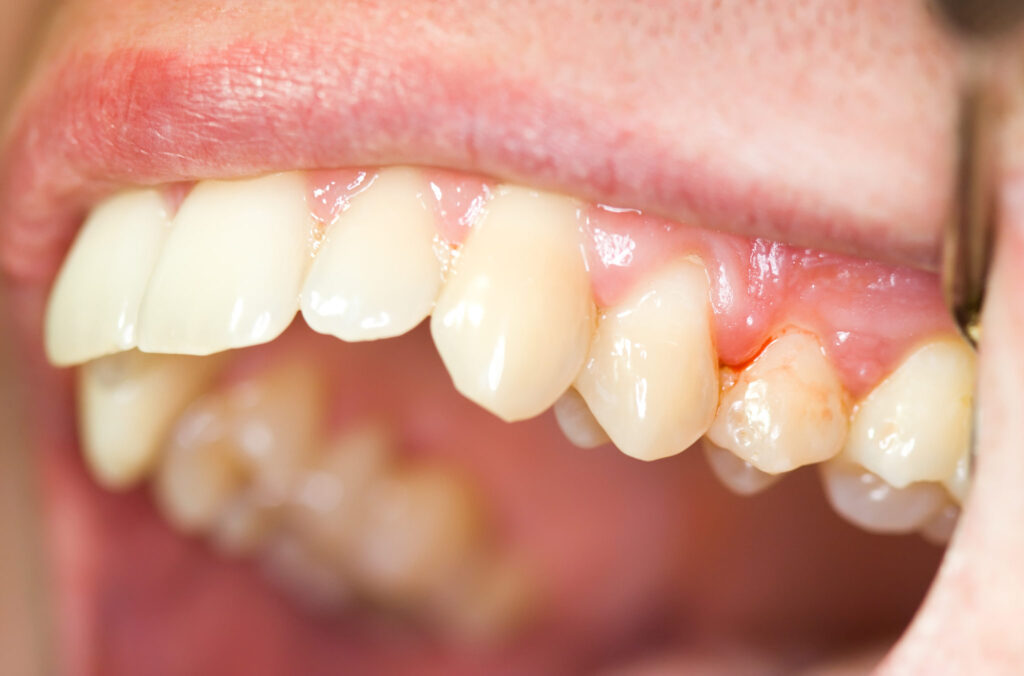
Turn Around Your Reversing Gum Disease: A Comprehension Guide
Gum disease, also known as periodontal disease, is an infection of the tissues and bones that support the teeth. It is one of the most common and serious oral health issues that affects adults worldwide. Fortunately, gum disease can be reversed with proper and timely treatment plan. Gum disease is caused by health conditions, lifestyle factors and poor oral hygiene habits such as irregular brushing and flossing. People with diabetes, hormonal changes, smoking, genetic predisposition, and some medications are at higher risk of developing gum disease. Symptoms of gum disease can range from swollen or tender gums, receding gums, bad breath, and loose teeth. Left untreated, gum disease can cause severe oral health problems, including tooth loss, infections, and cardiovascular diseases. Therefore, it is important to recognize the symptoms and get timely treatment to prevent further complications. The best way to reverse gum disease is through early diagnosis and appropriate treatment. Diagnostic tests such as periodontal charting and scaling are done to detect the presence of gum disease and to determine the extent of the damage. Treatment options for reversing gum disease include deep cleaning, medication, and surgical procedures. Non-surgical options such as mouth rinses, antibacterial toothpaste and special diet plans can also be used to treat gum disease. At home, there are a few steps people can take to prevent and reverse gum disease. These include brushing and flossing twice a day, using mouthwashes, and eating a balanced diet. Additionally, it is also important to visit the dentist regularly to get professional advice and treatment. Although it is difficult to completely cure gum disease, with the right treatment and care, people can keep it under control and even reverse its effects.
Symptoms of Gum Disease
Gum disease, also known as periodontal disease, is a condition caused by bacteria in the mouth. It can cause inflammation and can lead to oral health problems if it’s left untreated. The main symptoms of gum disease include:
- Bleeding gums – when your gums bleed when you brush or floss, it could be a sign of gum disease.
- Swollen gums – swollen and tender gums can be a sign of gum disease.
- Receding gums – if your gums start to pull away from your teeth, it could be a sign of gum disease.
- Bad breath – if you have bad breath that won’t go away, it could be an indication of gum disease.
- Loose teeth – if your teeth start to become loose, it could be a sign of advanced gum disease.
If you are experiencing any of these signs or symptoms, you should seek advice from a dentist as soon as possible. Gum disease can be reversed with the right treatment and care, so it is important to get help before it progresses.

Risks and Complications of Gum Disease
Gum disease can lead to a number of serious complications if left untreated. It can cause infection, tooth loss, and can even increase your risk of developing cardiovascular problems. Understanding the risks associated with gum disease can help you make informed decisions about your oral health.
One of the primary risks of gum disease is infection. Your gum tissue becomes inflamed, which can cause the growth of bacteria in the area. This bacteria can lead to infections in the gums, bone, and other tissues. It can also cause swelling, pain, and bad breath.
Another risk of gum disease is tooth loss. As the gum tissue is destroyed by the inflammation, the teeth may begin to loosen or fall out. Loose teeth can become infected and can be lost if not treated quickly.
In addition, gum disease can increase your risk of developing cardiovascular problems. Studies have shown that people with gum disease are more likely to develop heart disease and stroke than those without it. The infection and inflammation caused by gum disease can enter the bloodstream, leading to an increased risk of these conditions.
It’s important to be aware of the possible risks and complications of gum disease so that you can take steps to prevent it. Good oral hygiene and regular visits to the dentist can help reduce your risk of developing serious health problems due to gum disease.
Causes of Gum Disease
Gum disease can be caused by a range of factors, including poor oral hygiene, certain health conditions, and lifestyle choices. Here are some of the common causes of gum disease:
- Poor Oral Hygiene: Not brushing and flossing your teeth regularly and correctly is one of the primary causes of gum disease. When plaque and bacteria start to accumulate on the teeth and gums, the gums become irritated and start to pull away from the teeth leading to gum pockets and infection.
- Lifestyle Factors: Smoking and using alcohol, as well as other recreational drugs, increase the risk of developing gum disease. Incorrect eating habits, such as eating sugary snacks and drinks, can also contribute to gum disease.
- Health Conditions: Certain medical conditions, such as diabetes, increase the risk of developing gum disease. This is because some medical conditions reduce the body’s ability to fight off infection, making the gums more vulnerable to bacterial invasion.
It is important to be aware of the causes of gum disease and to take steps to prevent it from occurring. This can include seeing your dentist regularly and following good oral hygiene habits.
Diagnostic Tests for Gum Disease
When diagnosing gum disease, dentists will use a variety of tests to identify the condition and assess its severity. Some of the most common tests used to detect gum disease include periodontal charting, scaling, and x-rays.
Periodontal Charting
Periodontalcharting is the process of measuring the depth of the pockets around your teeth. The dentist will insert a small probe between your teeth and measure the depth of the pockets. If there are deeper than 3 millimeters, this could be a sign of gum disease.
Scaling
Scaling involves removing plaque and calculus (tartar) from the surface of the teeth. This procedure helps to remove bacteria that can cause gum disease, as well as improve the overall appearance of your teeth.
X-Rays
X-rays can be used to look at the condition of your teeth on a larger scale. X-rays help dentists to identify bone loss, which is an indication of advanced gum disease.
Overall, these diagnostic tests are important tools in detecting and diagnosing gum disease. By identifying the condition early on, it can be easier to manage and reverse.
Treatment Options for Reversing Gum Disease
When it comes to reversing gum disease, there are several treatment options available. Depending on the severity of your gum disease, your dentist may recommend one or more of the following treatments:
- Deep Cleaning: Also known as “scaling and root planing”, deep cleaning involves the removal of bacteria, tartar and plaque from the surface of your teeth and gums. This is often done over multiple visits, and even with repeated cleaning, your gums may not completely return to health.
- Medications: Your dentist may prescribe medications to help reduce inflammation and pain associated with gum disease. These can be topical, such as a gel or rinse, or systemic, such as antibiotics.
- Surgery: In some cases, surgery may be necessary to restore your gums back to health. This may involve flap surgery, bone grafting or soft tissue grafts.
It’s important to remember that different treatments will be more effective for some people than others, so it’s best to discuss your options with your dentist before deciding what’s right for you.
Non-Surgical Options for Treating Gum Disease
When it comes to treating gum disease, there are many different non-surgical options available. These can be used alone or in combination to help reduce symptoms and stop the progression of gum disease.
Mouth rinses are a popular non-surgical option for treating gum disease. These products can help to reduce bacteria in the mouth, reduce plaque and improve oral health overall. Antibacterial toothpaste is another popular choice, as it can help to remove bacteria from the teeth and gums.
Another non-surgical option for treating gum disease is to follow a special diet plan. Eating a balanced diet filled with fruits and vegetables, whole grains and lean proteins can help to reduce inflammation in the mouth, as well as boost your overall health.
If you’re considering any of these non-surgical options for treating gum disease, it’s important to speak to your dentist for further advice. They’ll be able to provide you with more information about the best course of treatment for your individual needs.
Home Remedies for Reversing Gum Disease
Reversing gum disease naturally can be done through simple home remedies. It is important to maintain a good oral hygiene routine and regularly visit the dentist, but there are also additional methods that can help to reverse gum disease.
Salt Water Rinses
Salt water rinses are a simple and effective way to reduce inflammation and heal your gums. To make the solution, add a teaspoon of salt to a cup of warm water and mix until it is dissolved. Swish the solution around in your mouth for 30 seconds before spitting it out. Repeat this process two times a day for 1-2 weeks and you should start to see a reduction in inflammation and swelling.

Flossing
Flossing is also important for reversing gum disease as it helps to remove plaque and debris from in between your teeth which can lead to inflammation and infection. You should floss once a day and make sure to do it gently to avoid damaging your gums.
Eating Healthy
Maintaining a healthy diet and avoiding sugary snacks or drinks can drastically reduce the risk of gum disease. Eating a balanced diet full of fruits, vegetables, and whole grains will help to strengthen your teeth and gums and prevent any further damage.
Quit Smoking
Smoking is one of the main causes of gum disease, so if you are a smoker, it is important to quit in order to reverse the damage that has been done. Not only will quitting smoking help to reverse gum disease but it will also have a positive impact on your overall health. Following these simple steps can help to reverse gum disease and restore your gums to their healthy state. Remember to always follow the advice of your dentist and to keep up with regular check-ups to ensure your gums remain healthy.

Preventing Gum Disease
Gum disease can be prevented by taking care of your oral health. Practising good oral hygiene and seeing your dentist regularly can help you keep your gums healthy and reduce the risk of developing gum disease. Here are some key tips for preventing gum disease:
- Brush twice a day with fluoride toothpaste
- Floss at least once a day
- Drink plenty of water
- Eat a balanced diet
- Avoid smoking and tobacco products
- Visit your dentist for regular checkups and cleanings
If you are experiencing any signs or symptoms of gum disease, it’s important to visit your dentist right away. Early diagnosis and treatment are key to reversing and preventing gum disease.
The Prognosis for People with Gum Disease
The prognosis for people with gum disease depends on the severity of the infection and how it is treated. In most cases, with the right treatment and diligent oral hygiene habits, the effects of gum disease can be reversed and the patient’s oral health can be restored. It is essential to receive regular check-ups at the dentist, so that any warning signs of gum disease can be identified quickly and appropriate action can be taken.
For mild cases of gum disease, brushing twice daily and flossing regularly may be enough to restore oral health. However, moderate to severe cases may require additional treatment. This could range from a deep cleaning procedure known as scaling and root planing, to medications and in some cases surgery.
It is also important to make lifestyle changes that reduce the risk of developing gum disease and prevent its progression. This includes quitting smoking and cutting down on foods and beverages that are high in sugar, and replacing them with healthier alternatives. Additionally, reducing stress levels, maintaining a healthy diet and exercising regularly can all help to reduce the risk of developing gum disease.
With prompt diagnosis and early treatment, gum disease can usually be reversed in most cases. However, it is important to stay vigilant and practice good oral hygiene habits to avoid further complications.
Questions to Ask Your Dentist about Reversing Gum Disease
If you are concerned about your gum health and want to take steps to reverse gum disease, it’s important to talk to your dentist. Your dentist can provide you with more information about your individual condition, as well as give you advice on how to proceed with reversing the disease. Here are some questions to ask your dentist about reversing gum disease:
- What treatment options are available for reversing my gum disease?
- Are there any non-surgical treatments that could help to reverse my gum disease?
- What steps can I take at home to help reverse my gum disease?
- Are there any lifestyle changes I should make to reduce the risks of further gum disease?
- How often should I visit my dentist for gum disease checkups?
- How can I find out more information about my specific gum disease?
Asking your dentist these questions can help you understand the best ways to reverse your gum disease. Remember to always follow your dentist’s advice in order to protect your oral health.
Gum disease is an oral health issue that should never be taken lightly. If left untreated, it can lead to severe complications and even tooth loss. Fortunately, with the right knowledge and treatment plan, it is possible to reverse gum disease and restore your oral health. In this guide, we have discussed the symptoms, risks, causes, diagnostic tests, treatments and prevention of gum disease, as well as the prognosis for people with gum disease and questions to ask your dentist about reversing the condition. It is important to maintain good oral hygiene habits and regular visits to your dentist in order to help prevent and treat gum disease. An early diagnosis is the key to successful reversing of gum disease, so don’t hesitate to speak to your dentist if you notice any symptoms or feel something is wrong. With the right treatment plan and diligence, it is possible to reduce the effects of gum disease and maintain a healthy mouth. “
Frequently Asked Questions about Reversing Gum Disease
- Q: What is reversing gum disease?
A: Reversing gum disease is the process of treating or reversing the effects of periodontal disease, which causes inflammation and irritation of the gums and can lead to complications such as tooth loss, infections, and cardiovascular disease. - Q: What are the symptoms of gum disease?
A: Symptoms of gum disease include reddened and swollen gums, bleeding gums, loosening teeth, bad breath, receding gums, and pain when chewing. - Q: What are the possible risks and complications associated with gum disease?
A: Risks and complications of gum disease include infections, tooth loss, bone loss, and cardiovascular disease. - Q: What are the causes of gum disease?
A: Gum disease is caused by health conditions, lifestyle factors, and poor oral hygiene habits. - Q: What are the treatment options for reversing gum disease?
A: Treatment options for reversing gum disease include deep cleaning, medications, and surgery. Non-surgical treatment options include mouth rinses, antibacterial toothpastes, and special diet plans. - Q: Are there any home remedies to reverse gum disease?
A: Home remedies to reverse gum disease include salt water rinses and regular flossing. - Q: What is the prognosis for people with gum disease?
A: The prognosis for people with gum disease depends on how advanced the condition is, how quickly it is treated, and how well preventive measures are taken to prevent its progression.
